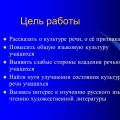First, we present our information about the classification of substances in the form of a diagram (Scheme 1).
Scheme 1
Classification of inorganic substances
Knowing the classes of simple substances, it is possible to create two genetic series: the genetic series of metals and the genetic series of non-metals.
There are two varieties of the genetic series of metals.
1. Genetic series of metals to which alkali corresponds as a hydroxide. In general, such a series can be represented by the following chain of transformations:
For example, the genetic series of calcium:
Ca → CaO → Ca(OH) 2 → Ca 3 (PO 4) 2.
2. Genetic series of metals that correspond to an insoluble base. This series is richer in genetic connections, since it more fully reflects the idea of mutual transformations (direct and reverse). In general, such a series can be represented by the following chain of transformations:
metal → basic oxide → salt →
→ base → basic oxide → metal.
For example, the genetic series of copper:
Cu → CuO → CuCl 2 → Cu(OH) 2 → CuO → Cu.
Here, too, two varieties can be distinguished.
1. The genetic series of nonmetals, to which a soluble acid corresponds as a hydroxide, can be reflected in the form of the following chain of transformations:
non-metal → acidic oxide → acid → salt.
For example, the genetic series of phosphorus:
P → P 2 O 5 → H 3 PO 4 → Ca 3 (PO 4) 2.
2. The genetic series of nonmetals, which correspond to an insoluble acid, can be represented using the following chain of transformations:
nonmetal → acid oxide → salt →
→ acid → acid oxide → non-metal.
Since of the acids we have studied, only silicic acid is insoluble, as an example of the last genetic series, consider the genetic series of silicon:
Si → SiO 2 → Na 2 SiO 3 → H 2 SiO 3 → SiO 2 → Si.
Key words and phrases
- Genetic connection.
- Genetic series of metals and its varieties.
- Genetic series of nonmetals and its varieties.
Work with computer
- Refer to the electronic application. Study the lesson material and complete the assigned tasks.
- Find email addresses on the Internet that can serve as additional sources that reveal the content of keywords and phrases in the paragraph. Offer your help to the teacher in preparing a new lesson - make a report on the key words and phrases of the next paragraph.
Questions and tasks
In this article we will talk about genetic series of metals. Individual chemical substances are usually divided into 2 groups: simple substances And complex.
This diagram gives a simplified idea of genetic sequence of metals.
On top are a group of metals and hydrogen, the structure of which differs from the structure of atoms of other elements. There is 1 electron in the outer level, like in alkali metals, but at the same time there is not enough 1 electron to fill the outer level.
Based on genetic line metals form basic oxides. Hydrogen forms a specific amphoteric oxide - water H2O, which, when interacting with the main oxide, gives a base (alkali). Such reactions proceed, as a rule, without changing the oxidation state. With change, only those reactions occur in which complex substances are formed from simple substances:
2 Cu + O 2 = 2 CuO,
Basic oxides react with nonmetals, acidic oxides, acids, acid salts.
Depending on the acid, metal or non-metal, different salts are formed. For example:
Cu(HE) 2 + H 2 SO 4 = SO 4 .
The material world in which we live and of which we are a tiny part is one and at the same time infinitely diverse. The unity and diversity of the chemical substances of this world is most clearly manifested in the genetic connection of substances, which is reflected in the so-called genetic series. Let us highlight the most characteristic features of such series.
1. All substances in this series must be formed by one chemical element. For example, a series written using the following formulas:
2. Substances formed by the same element must belong to different classes, i.e., reflect different forms of its existence.
3. Substances that form the genetic series of one element must be connected by mutual transformations. Based on this feature, it is possible to distinguish between complete and incomplete genetic series.
For example, the above genetic series of bromine will be incomplete, incomplete. Here's the next row:
can already be considered complete: it began with the simple substance bromine and ended with it.
Summarizing the above, we can give the following definition of the genetic series.
Genetic series- this is a series of substances - representatives of different classes, which are compounds of one chemical element, connected by mutual transformations and reflecting the common origin of these substances or their genesis.
Genetic connection- a more general concept than the genetic series, which is, albeit a vivid, but particular manifestation of this connection, which is realized during any mutual transformations of substances. Then, obviously, the first given series of substances also fits this definition.
There are three types of genetic series:
The richest series of metals exhibits different oxidation states. As an example, consider the genetic series of iron with oxidation states +2 and +3:

Let us recall that to oxidize iron into iron (II) chloride, you need to take a weaker oxidizing agent than to obtain iron (III) chloride:

Similar to the metal series, the non-metal series with different oxidation states is richer in bonds, for example, the genetic series of sulfur with oxidation states +4 and +6:

Only the last transition can cause difficulty. Follow the rule: in order to obtain a simple substance from an oxidized compound of an element, you need to take for this purpose its most reduced compound, for example, a volatile hydrogen compound of a non-metal. In our case:
This reaction in nature produces sulfur from volcanic gases.
Likewise for chlorine:
3. The genetic series of the metal, which corresponds to amphoteric oxide and hydroxide,very rich in bonds, because depending on the conditions they exhibit either acidic or basic properties.
For example, consider the genetic series of zinc:

Genetic relationship between classes of inorganic substances
Characteristic are reactions between representatives of different genetic series. Substances from the same genetic series, as a rule, do not interact.
For example:
1. metal + non-metal = salt
Hg + S = HgS
2Al + 3I 2 = 2AlI 3
2. basic oxide + acidic oxide = salt
Li 2 O + CO 2 = Li 2 CO 3
CaO + SiO 2 = CaSiO 3
3. base + acid = salt
Cu(OH) 2 + 2HCl = CuCl 2 + 2H 2 O
FeCl 3 + 3HNO 3 = Fe(NO 3) 3 + 3HCl
salt acid salt acid
4. metal - main oxide
2Ca + O2 = 2CaO
4Li + O 2 =2Li 2 O
5. non-metal - acid oxide
S + O 2 = SO 2
4As + 5O 2 = 2As 2 O 5
6. basic oxide - base
BaO + H 2 O = Ba(OH) 2
Li 2 O + H 2 O = 2LiOH
7. acid oxide - acid
P 2 O 5 + 3H 2 O = 2H 3 PO 4
SO 3 + H 2 O =H 2 SO 4





